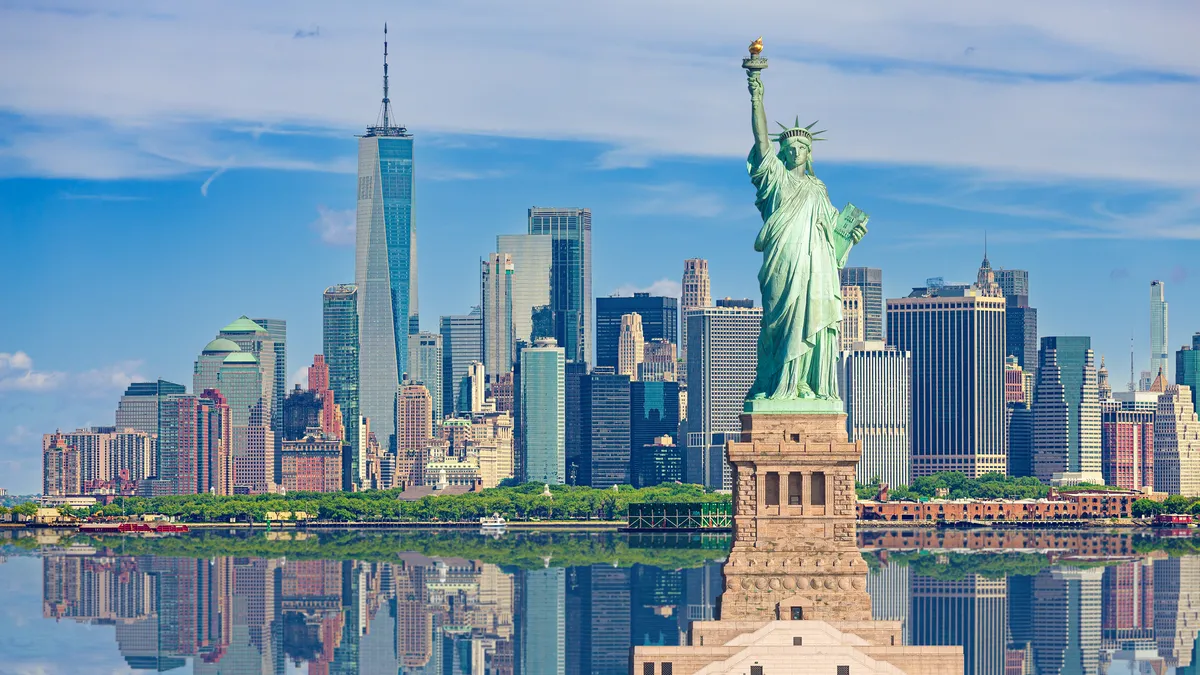Dive Brief:
- New York’s mandatory emissions limits for concrete used in state-funded public building and transportation projects will go into effect Jan. 1, 2025, Gov. Kathy Hochul announced last week. They stem from a law signed in 2021 that called for these guidelines to be developed.
- The Buy Clean Concrete guidelines apply to all state agency contracts exceeding $1 million that involve the use of more than 50 cubic yards of concrete, or New York DOT contracts exceeding $3 million that include at least 200 cubic yards of concrete. The guidelines include exceptions for emergency projects and those requiring high-strength or quick-cure concrete and do not apply to state authorities, according to the release.
- The rules represent the first state-level mandate in the country to implement greenhouse gas emission limits covering all agency projects, according to the release.
Dive Insight:
The guidelines mandate that environmental product declarations must be submitted for all concrete mixes used in qualifying state construction projects and must demonstrate that they achieve an environmental impact below the limits set by the state, effective Jan. 1, 2025. Officials are working toward providing concrete producers with the technical assistance they need to meet these EPD requirements, the release said.
With some of the nation’s most aggressive climate and clean energy initiatives, New York aims to achieve a zero-emission electricity sector by 2040, including 70% renewable energy generation by 2030 and economy-wide carbon neutrality by 2050, according to Hochul’s office.
The guidelines will impact construction costs and the availability of concrete, according to Sarah Patrie, vice president of transportation services at the Associated General Contractors of New York State.
“Producers are going to need to invest over the next three to 15 months in upgrading equipment, technology and methods to pursue environmental product declarations and reduce emissions,” Patrie said in an email. “We anticipate the impacts will be greater in the rural areas of New York state where concrete producers tend to be smaller plants, geographically further from project locations and service a lower annual volume of concrete than those in more urban areas.”
Nationwide, concrete prices jumped 0.5% in August and remain 8.7% higher than August 2022, according to Associated Builders and Contractors’ analysis of U.S. Bureau of Labor Statistics producer price index data.
Looking ahead
Nevertheless, guidelines like this provide an opportunity for innovation, especially as the industry shifts toward a more sustainable future, said Patrie. The key priority needs to be the strength and durability of concrete mixes, she added, while accounting for workability and final finishing requirements on projects.
Carlo Scissura, president and CEO of the New York Building Congress, applauded the move to slash emissions from concrete.
“The building industry, like every sector, has a responsibility to embrace more sustainable, cleaner systems and materials to combat climate change,” Scissura said in an email. “While there are a lot of unknowns as New York makes this transition, we will work closely with our members and government partners to ensure that the industry can keep on building sustainably without being negatively impacted.”
The guidelines support the governor’s Leading by Example initiative, which requires state agencies to collect New York-specific data from common construction materials, including concrete. That information will be used to set lower limits on greenhouse gas emissions from concrete, starting in 2027.
“Adopting Buy Clean Concrete guidelines marks a monumental step in our journey toward a more sustainable and eco-friendly New York State,” Hochul said in the release. “By setting mandatory emissions limits on concrete used in state-funded projects, we’re not just leading by example but creating a tangible roadmap for reducing greenhouse gas emissions across the board.”













